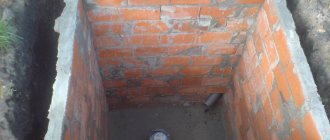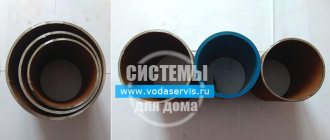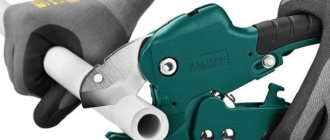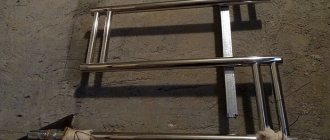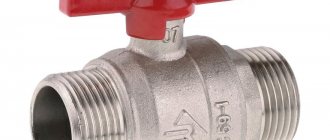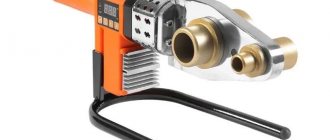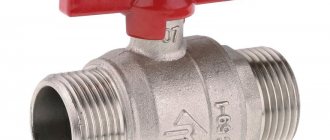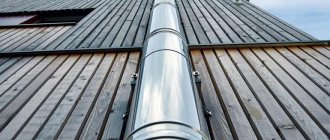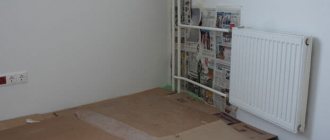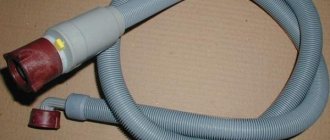Water supply from a well is the most common type of water supply for individual houses in the absence of a central water main. After drilling, it is buried underground below the freezing depth in order to gain convenient access to the mouth, install pumping equipment and connect water pipes; a deep hole with finished walls is used - a caisson for the well.
The installation of a caisson for a well after drilling it is usually carried out during the construction stage - to build a house you need a lot of water, cleaning systems and protection of the well source from freezing in winter are also necessary. When installing caissons, various installation methods and materials are used, in order to choose the best option, you should consider all their types from the point of view of cost and ease of further operation.
Rice. 1 Caisson for a well with pumping equipment
Well caisson - what is it?
A caisson for arrangement is a waterproof tank made of metal or plastic.
Structures made from concrete rings are considered an obsolete option and are falling out of use. The reservoir can be square or rectangular in shape. Tank height: not less than 2 m, base area - not less than 1 sq. m.
Well caisson functions:
- Saving free space inside the house.
- Protection of the mouth from groundwater ingress.
- Protection of installed equipment from freezing in winter.
- Providing quick access to installed equipment.
- Silencing noise from a running pump.
produces caissons for wells under its own brand. This solution allows us to guarantee the quality of the tanks we install. And also reduce the price of equipment installation for customers.
Buden is interested: How to equip a water well after drilling - popular schemes.
Figure 1: Plastic caisson with equipment installed inside.
General information
Considering the caisson, what it is in construction, the structure can be defined as a hollow sealed chamber, mostly round in shape with a diameter of approximately 1 m, which is installed on top of the well pump.
Most often, the caisson is placed in a hole dug in a circle around the casing, with the casing's mouth located at a depth of 1-5 m. At the bottom of the device there is a hole for the well, at the top it is closed with a hatch for insulation. A ladder must be installed inside, which allows you to descend to the downhole equipment.
The ladder allows you to conveniently descend for installation, repair or routine maintenance of equipment Source eurolos.ru
Why a caisson is needed for a well is to protect the pumping station from bad weather conditions, seasonal temperature fluctuations, and the penetration of underground, waste and melt water.
Characteristics of a metal caisson
Metal caissons are made of steel 4-6 mm thick. Their design includes only one weld seam. The sealed container protects the mouth from dust, from groundwater, and from freezing. The metal structure can withstand strong soil pressure well. An insulated hatch is placed on the neck. Inside there are steps made in the form of brackets.
But the metal caisson has one serious drawback. The metal is destroyed by contact with groundwater and aggressive substances contained in the soil. An anti-corrosion coating can slow down this process, but not stop it completely.
To waterproof steel tanks, we coat their walls with bitumen varnish. It is possible to additionally cover the walls with waterproofing.
We will help you with choosing a caisson
Click on the button and order a call back from the Aqualux+ manager.
Order
Service life of a metal caisson: 25-30 years.
Figure 2: Metal caisson - schematic section.
Comparison of the advantages and disadvantages of both options
To better understand which is better: an adapter or a caisson and which option is better to choose for your well, we will compare these two technologies according to several important criteria.
- Price . The advantage here lies with the downhole adapter. The price of the device itself is disproportionately less than that of any type of caisson. The difference in cost becomes even more noticeable when you consider the need to hire a truck crane to install a massive coffered chamber;
- Labor costs . According to this indicator, coffered chambers are again inferior. To install the adapter, you only need to go deep along the casing below the freezing level of the soil. In the central part of Russia it is about 1 m, in Siberia it can reach 1.5-2 meters. One person can do all the work of installing it within a day. But to install a caisson, you will first have to dig a hole of large size and depth around the well, and then install the caisson chamber. The expenditure of effort and time in this case will be much greater;
- Durability . Properly installed and protected from the effects of precipitation and groundwater, the caisson can last for decades. This is especially true for modifications cast from polymer. Downhole adapters do not have the same durability. The rubber seals used in them may become unusable after 4-5 years, which will require dismantling the entire structure;
- Additional functions . The caisson chamber allows you to place inside a full set of water supply equipment: pump, hydraulic accumulator, filters, automatic control, etc. Reliable protection from cold and mechanical stress will ensure their reliable operation all year round. It is also possible to equip a branching system inside to supply water simultaneously to several levels and even buildings. This way you can provide water from one well to a garage, a summer water supply system, or several houses at once. A downhole adapter cannot provide anything like this. It has one working function - protecting the junction of the supply water supply pipe with the well pipe.
Characteristics of galvanized caisson
Galvanizing improves the anti-corrosion properties of the metal. Unprotected steel easily reacts with oxygen contained in the soil. This process is called oxidation. Iron-oxygen compounds are unstable and easily destroyed. After their destruction, oxygen penetrates deeper, causing the oxidation of subsequent molecules. This is how metal corrosion occurs.
Zinc has a different mechanism of interaction with oxygen. As a result of oxidation, a protective film consisting of oxides is formed on the surface of zinc. The film prevents oxygen molecules from penetrating deeper into the metal. Also, the zinc layer provides additional protection against moisture.
Metal sheets 4 mm thick are subjected to galvanizing. Galvanized sheets are used for welding containers of various shapes. Galvanizing sheets, rather than finished products, ensures an even application of the protective layer.
Service life of a galvanized tank: 35-40 years.
Figure 3: Galvanized caisson with increased durability.
Criterias of choice
A plastic caisson for well construction is designed to maintain optimal temperature in the tank. This can only be achieved if the structure is airtight. Therefore, access to the interior of the caisson is provided using a hinged hatch or cover on the surface.
The equipment must be equipped with good ventilation , as well as all necessary openings for pipelines and cable wires.
In the summer, near the caisson, you can install a water pump, which will be used to water the garden.
When choosing a caisson for an autonomous water supply system, it is necessary to take into account the dimensions of the pumping station and pressure tank. The distance from the casing entrance to the center of the tank depends on this criterion. During the installation of the hatch, it is necessary to ensure free and convenient access to the inside of the caisson installation.
To prevent groundwater from penetrating into the tank, the caisson holes must be carefully sealed before installing the tank in the soil.
In addition, experts recommend choosing a round caisson, because Such structures are subject to uniform load, which allows for maximum service life.
Characteristics of plastic caisson
Installing a plastic caisson is the best option for an artesian well. The plastic tank is not destroyed by water. A plastic tank will last 50-60 years. The service life of the tank coincides with the service life of the artesian well.
For the manufacture of caissons of the Aqualux Plast line, polypropylene is used. The tank design has 8 stiffening ribs. They increase the strength of the tank walls by bearing soil pressure. To increase the useful volume of the tank, we moved the stiffening ribs outward, to the outer surface of the walls.
The design of any model includes:
- Plastic tank.
- Sealed flange.
- Insulated hatch.
- Sealed hatch.
- Plastic ladder.
- Optional: locking eyes.
Reliable welds can withstand direct blows from a sledgehammer. There are hooks on the bottom of the tank for fixing in the ground. The temperature inside the plastic tank does not fall below +3C.
Prices for plastic caissons Aqualux Plast follow the link.
Figure 4: Construction of a plastic caisson.
Video description
Why the caisson was compressed is shown in this video:
Attention! In this case, hydro- and thermal insulation will not be required, but protection against compression by soil is required.
Filling a plastic caisson with concrete is mandatory. Source moikolodets.ru
To do this, the gap between the walls of the pit and the box is filled with concrete. High-strength mixture quality is not necessary in this case. As a rule, the solution is mixed in a proportion of 5 parts sand and 1 part concrete. This procedure is mandatory, even if there are stiffening ribs on the plastic box.
Differences of rectangular round shape
Both metal and plastic tanks differ in shape. Often the shape depends on the volume of the tank. In the Aqualux lines, small-volume tanks are made cylindrical, and large-volume tanks are made rectangular.
Cylindrical options are easy to install. It is easier to dig a round pit than a pit with right angles. The absence of corners ensures uniform pressure on the walls of the tank. This reduces the likelihood of leaks. Due to the absence of corners, the usable volume increases.
Rectangular options are larger in volume. An adult can stand and walk freely inside the tank. Corner connections are made by welding. The corners are strong and reliable.
Shape options do not affect the properties of the surface and its service life. Shape is not the main indicator for choosing a caisson.
Tools
The set of construction tools largely depends on the type of container, or rather, what material it is made of. However, in any case, a shovel and buckets are needed.
Advice! You can speed up the digging process by renting special equipment. But sometimes this is impossible due to its size and the difficulty of accessing the source.
The following tool is needed:
- Concrete mixer.
- Shovels.
- Master OK.
- Tamping.
- Hammer.
- Trowel.
- Level.
- Buckets and the like.
The work may require:
- Sand.
- Cement.
- Crushed stone.
- Pure water.
- Fittings.
- Additives (giving concrete improved properties) and so on.
Comparative table of caissons "Aqualux"
For comparison, we took models of the same volume, made from different materials:
| Option | Wall material | Wall thickness (mm) | Life time | Price, rub) |
| "Aqualux+ 1" | steel | 4 | up to 30 years old | 29 000 ₽ |
| "Aqualux Zinc 1" | Cink Steel | 4 | up to 40 years old | 31 800 ₽ |
| "Aqualux Plast 1" | plastic | 6 | from 50 years old | 42 000 ₽ |
You can see that metal tanks are cheaper than plastic ones. But their service life is shorter. Choose the type of caisson, taking into account the service life of the well and the budget for the work.
Disadvantages of a caisson made of concrete rings
We do not recommend using the option with reinforced concrete rings. There is one popular misconception associated with the installation of rings. It is believed that they are not destroyed by water, and the structure can last up to 100 years. But actually it is not.
Although concrete is indeed a durable material, it is not suitable for well improvement. The rings will gradually deteriorate after installation. But this is not the main drawback of the scheme.
The main problem is that the pipe insertion into the well cannot be made completely sealed. Water will constantly accumulate inside the lower ring.
Microcracks will form in the surface of the concrete, through which water will enter the well. Sooner or later it will penetrate the wellhead and mix with drinking water. This will lead to contamination of the source. Concrete rings are difficult to repair: leaks will occur with a certain frequency.
Buden is interested: The correct distance from the well to the house according to the standards.
Figure 5: What are you drinking? Groundwater inside the caisson entered the well.
How to do it yourself?
It is necessary to take into account a large number of nuances and carry out a number of preparatory work.
- Choosing a location. The well for the well is made in the same place where it was drilled. Therefore, there is not much choice here. It is important to take into account the pipe outlet. It doesn't have to be in the center. If the KDS is rectangular, then the exit may be on the side.
- Depth. The caisson made for the well must be placed taking into account negative temperatures. Otherwise, its effectiveness will be reduced to zero. This level differs in different regions of Russia.
- Trench for electrical cable and water supply. A ditch must be dug along which engineering systems are laid. The cable can be laid in the same trench as the water supply. But it should be placed in a protective casing. The depth of this trench should also be sufficient in cold weather.
- A pit is dug in the hole itself. It will be located around the casing.
- An important step is the process of insulating the walls. Waterproofing the structure from the outside is considered the most effective. Liquid bitumen is preferably used since a seamless coating can be achieved.
- As for insulation, it can be done from the inside if circumstances permit. It can also be done outside. In the latter case, the insulation must be protected from soil pressure. For example, when using rock wool, the soil will put pressure on the rock wool, reducing its effectiveness.
What is well construction?
Construction is a set of works that are carried out to create a water supply system. This concept usually includes the installation of equipment and connection of a residential building to the water supply.
We construct wells according to ready-made diagrams drawn up by engineers. All kits available for installation are listed in the table:
| Option name | Model | Pump type | Cost, rub.) |
| "Economy+" | "Aqualux+ 1" | Waterstry 2-70 | 135 926 ₽ |
| "Standard+" | "Aqualux+ 1" | Aquario 75-75 | 139 420 ₽ |
| "Comfort" | "Aqualux Plast 1" | Aquario 75-75 | 161 320 ₽ |
| "Premium" | "Aqualux+ 1" | Grundfos 2-70 | 228 676 ₽ |
| "Premium+" | "Aqualux Plast 1" | Grundfos 2-70 | 250 576 ₽ |
| "Lux" | "Aqualux+ 1" | Grundfos 3-65 | 174 326 ₽ |
| "Lux+" | "Aqualux Plast 1" | Grundfos 3-65 | 196 226 ₽ |
A warranty is issued for the installed equipment. System maintenance must be carried out once every 6 months.
Caisson installation technology
Installation begins with digging a pit. You can dig a pit and a trench for water pipes manually. This does not require the use of an excavator. The width of the pit should be such that there is at least 15 cm between the walls and the ground. The depth of the pit should be 15 cm less than the height of the tank.
Figure 6: Pit preparation.
The base of the pit is leveled. The casing pipe is cut above the level of the bottom of the pit. A hole is cut in the bottom of the tank for installation on the well. After the caisson is lowered into the pit, the connection point is sealed and insulated. A sleeve is installed at the connection point. Sealed connections are provided for the entry of pipes and cables.
Figure 7: Lowering and anchoring the caisson.
When installing the plastic caisson, a concrete ring is mounted on the neck. It serves to anchor the tank and prevents the tank from moving or floating up. The mass of the ring compensates for the low weight of the tank. After connecting the equipment, the tank is closed with a hatch.
Figure 8: Installed caisson.
Video description
The features of installing a concrete caisson are described in detail in this video:
Installation of a metal structure
Installation of an iron structure will necessarily require a concrete slab as a foundation. Before fastening the structure from the outside, it is finished with waterproofing, and the inside is coated with a primer. This is a mandatory requirement even for stainless steel. Insulation is also necessary.
Step-by-step instructions on how to make a caisson for a well:
- a hole is dug.
- The foundation is prepared - a sand and gravel cushion, and a reinforced concrete slab is installed on top.
- The well casing is cut to height.
Casing pipes must be selected taking into account the diameter of the pressure pipeline Source ytimg.com
- A caisson is installed on top of the pit on metal supports, and the pipes of the sleeve and the well must coincide.
- additional trenches are dug to bring the pipeline to the house.
- All communication systems are installed.
- thermal insulation is attached.
- the structure is covered with earth.
When considering a caisson for a well, what kind of product it is and how it will be used, it is necessary to take into account differences in the design, therefore the installation diagram sometimes changes taking into account specific tasks and conditions. But it is recommended to dig trenches for connecting communications after attaching the caisson - simply jumping over various ditches at this time is not very convenient.
Is it possible to install a caisson yourself?
Proper installation of the caisson requires professional skills and knowledge. Installation errors will lead to displacement of the tank. After self-installation, there is a high risk of flooding the tank with groundwater.
Installing the tank is quite difficult. To install the container you will need a large set of tools and materials. Installing the tank will require the efforts of 2-3 strong men. To lift a metal tank and install it in a pit, you will need special equipment. Weight of metal containers: not less than 230 kg.
Professionals will install the equipment in a few hours. Installing the equipment yourself will take from several days to a week.
By ordering equipment installation from professionals, you will save time, effort and money. You will receive a guarantee for all elements of the water supply system. (If you install it yourself, the warranty may not apply.)
Order installation from professionals
Click on the button and order a call back from the Aqualux+ manager.
Order
Video description
To see what errors can occur when installing a caisson, watch this video:
Also, the diameter of the installed casing tube must be 500 mm larger than the cross-section of the pressure pipe, the height of the caisson itself is at least 2400 cm, while the upper chamber must be above ground level, to prevent rainwater from entering it. For the same reason, the hatch must be sealed.
An installed caisson on the territory of a private house should not disturb residents Source strojdvor.ru
What equipment is inside
A pumping station is needed to lift water from depth. This is one of the key elements of the water supply system. A stable supply of water to the system depends on the operation of the pump. We install branded pumps, the quality of which is beyond doubt:
- Aquario.
- Waterstry.
- Grundfos.
The hydraulic tank is not needed to store a supply of water, although this is one of its functions. But the main function of the accumulator is to equalize the pressure in the system. Inside the hydraulic tank there are reserves of liquid and air. By equalizing pressure, the hydraulic tank reduces the number of pump starts, extending its service life.
The automation system controls the operation of the equipment. The kit includes a pressure switch, flow switch, dry running switch, frequency converter, pressure gauge and other devices. The automation system controls the flow pressure and protects devices from breakdowns.
Purpose
To ensure uninterrupted operation of an autonomous water supply system, it is necessary to understand a number of nuances of the design and operation of a well. In low temperature conditions, the liquid begins to freeze. For water carriers located below the soil freezing zone, this does not matter. However, during frost, the pumping unit may break down. The water in it will turn to ice and expand, which may cause damage to the pipeline.
Plastic caissons are designed to protect this equipment.
These devices are special tanks equipped with a sealed lid. The vessel is attached to the casing at a depth of 1-2 meters, providing effective protection of the entire system at subzero temperatures. Additionally, you can install a connecting pipe to connect a watering hose.
Modern caisson models can be installed not only on the street, but also in any other place, including the cellar.
